The Impact of Snow Grooming on Morphology and Erosion of Alpine Hillslopes: A Case Study from Kasprowy Wierch Ski Station in the Tatra Mountains
Abstract
1. Introduction
2. Materials and Methods
2.1. Study Area

2.2. Methods and Data Sources
3. Results
3.1. Spatial Distribution and Morphometry of Landforms
3.1.1. Morphometric Characteristics of Landforms in 2012
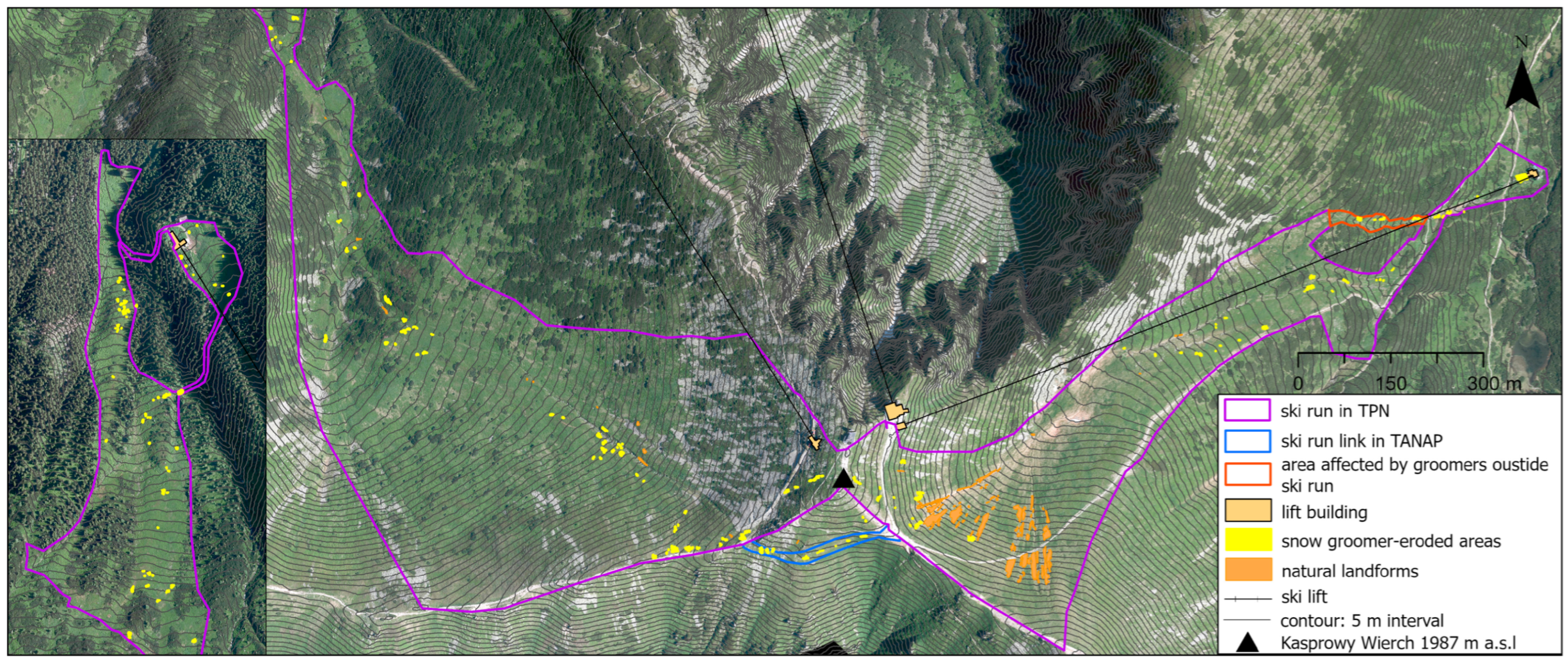
3.1.2. Morphometric Characteristics of Landforms in 2019
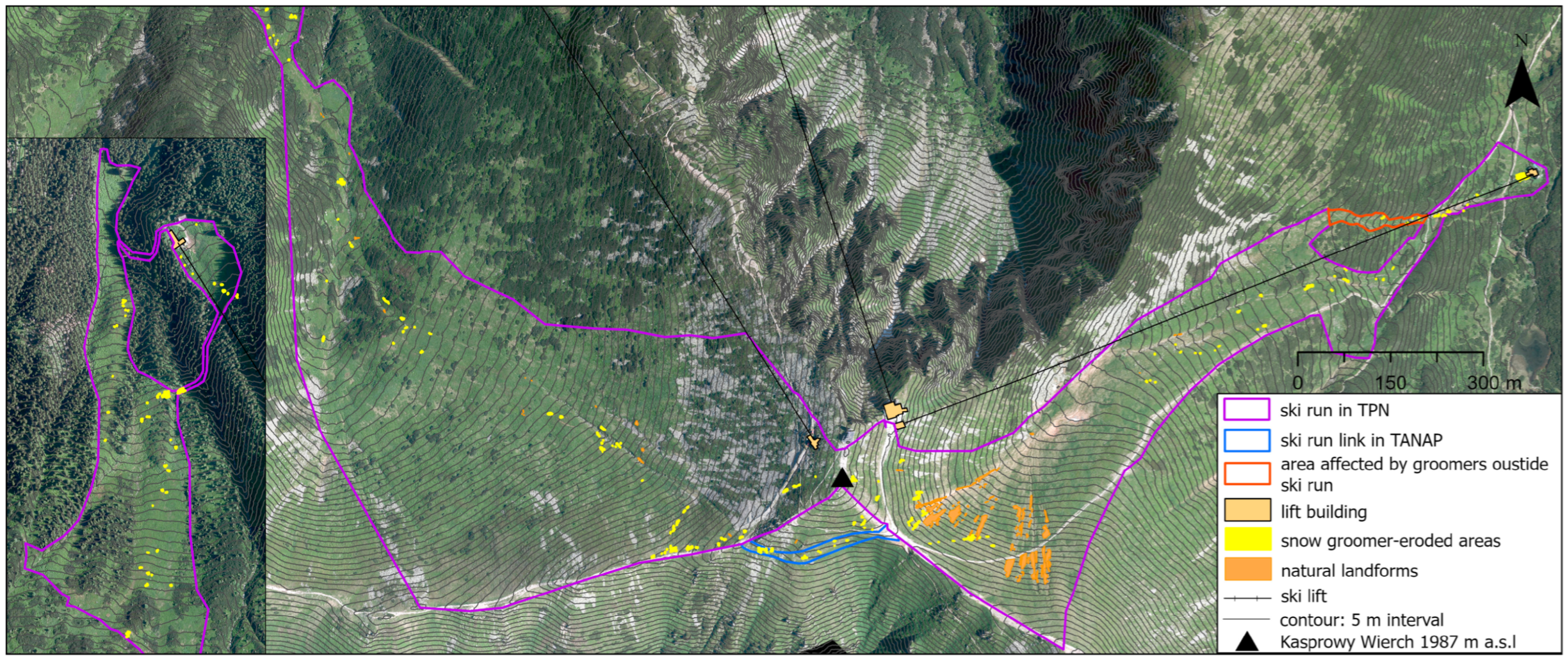
3.1.3. Morphometric Characteristics of Landforms in 2020
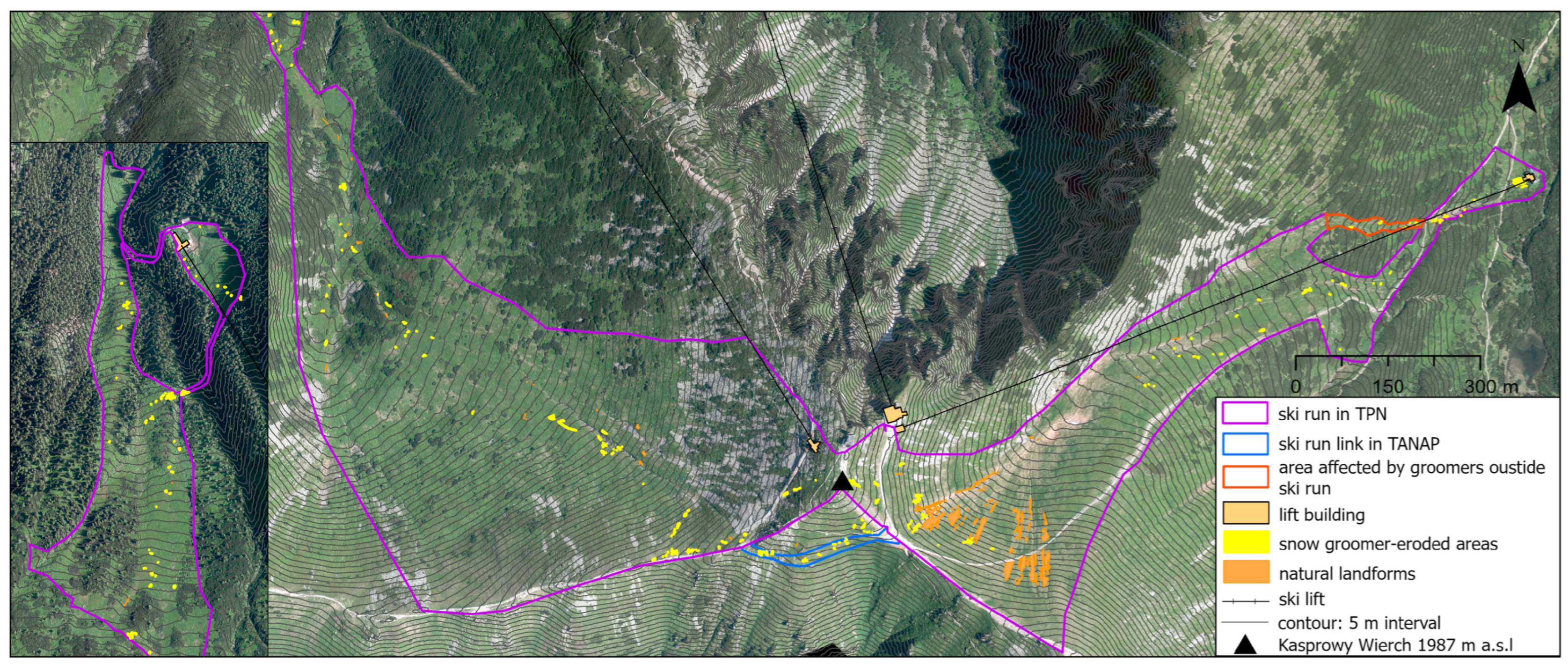
3.1.4. Morphometric Characteristics of Landforms in 2023

3.2. Persistent Landforms Throughout the Study Period
3.2.1. Morphometric Differences in Persistent Landforms

3.2.2. Statistical Differences in Persistent Landforms Characteristics
3.2.3. Statistical Differences in Morphometry of Persistent and Non-Persistent Snow Groomer-Eroded Landforms
3.3. Volumetric Changes and Erosion/Deposition Processes
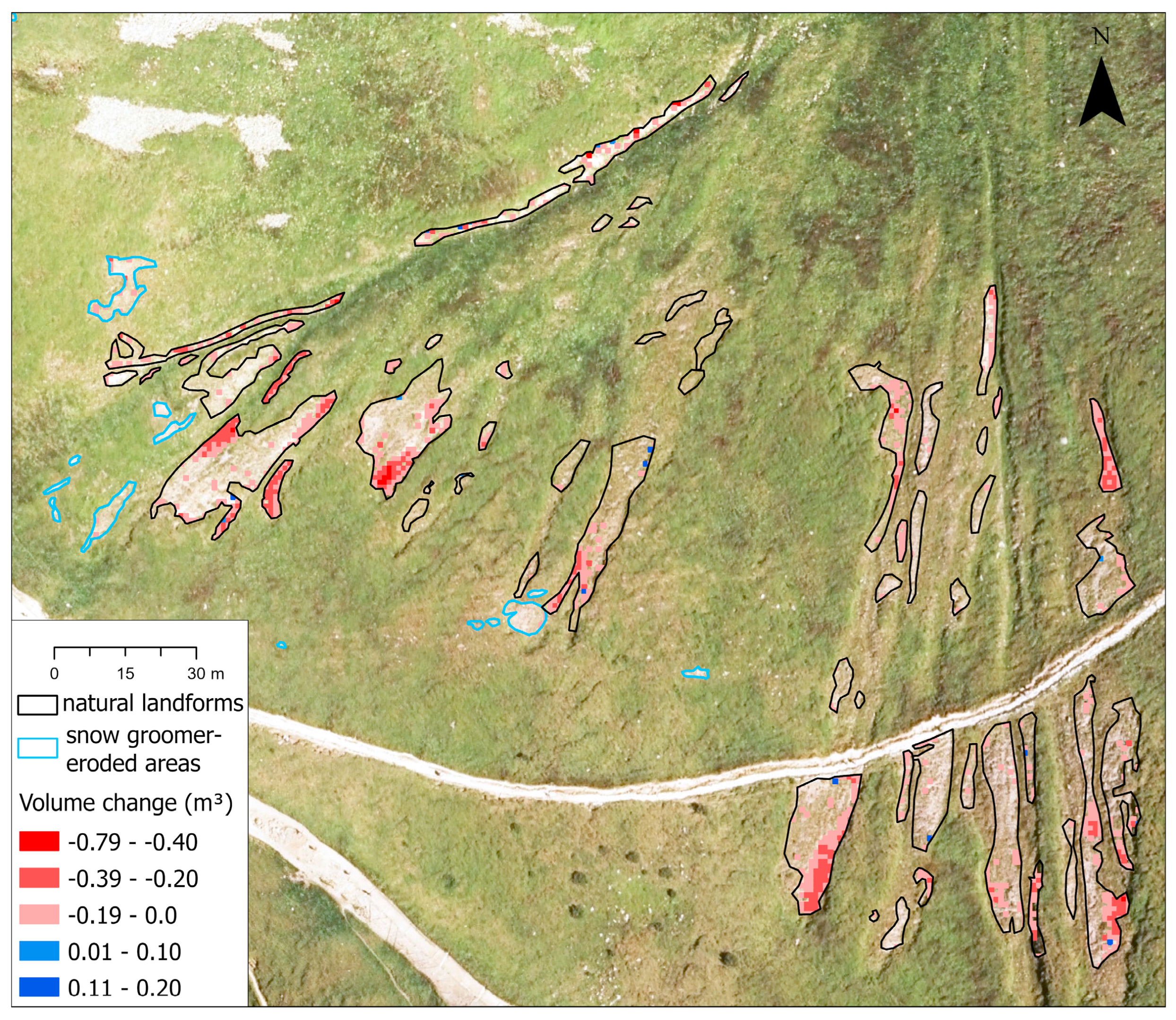
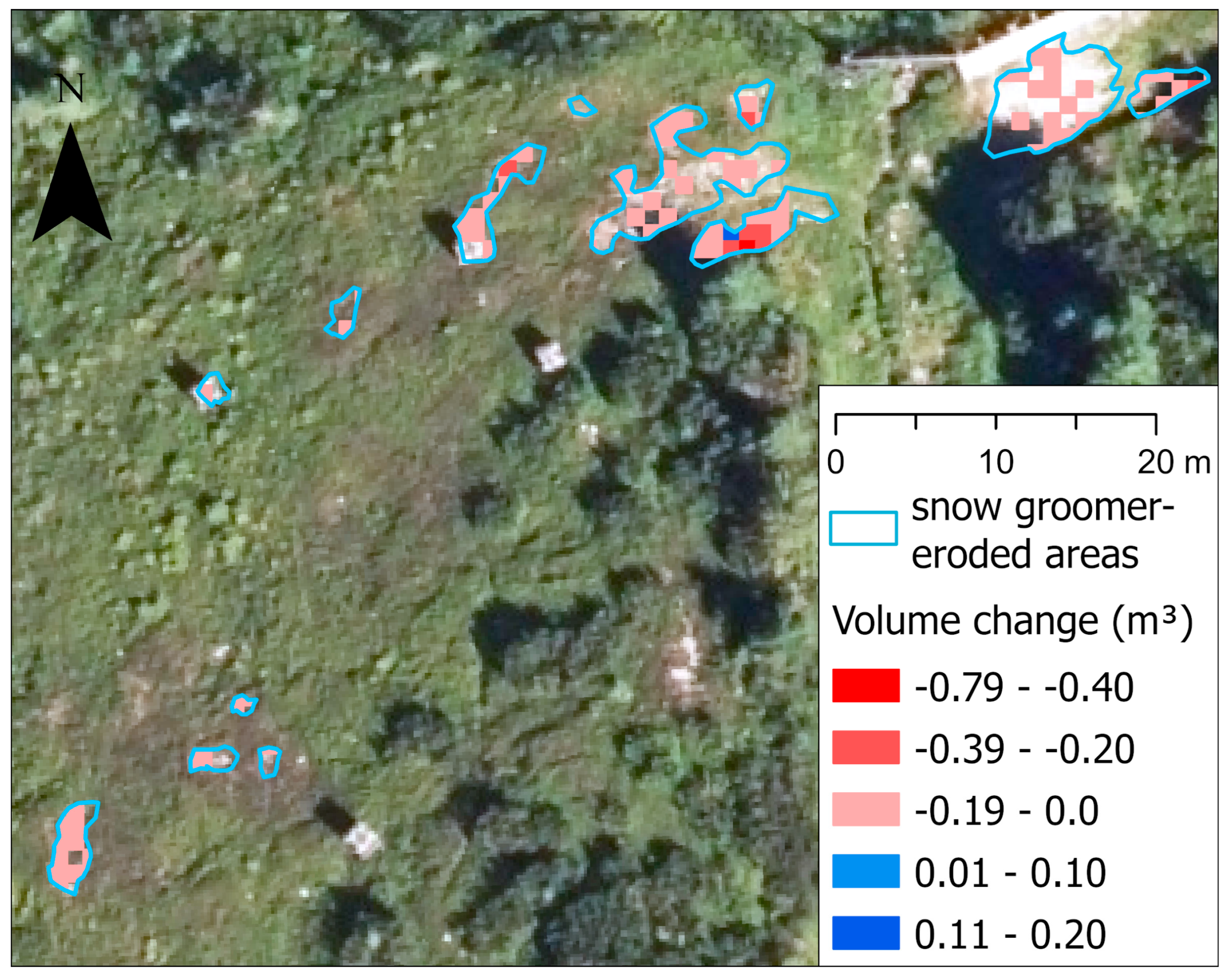
4. Discussion
4.1. Morphometric Characteristics and Persistence of Natural and Groomer-Eroded Landforms
4.2. Volumetric Changes: Contrasting Long-Term Trends with a High-Intensity Event
4.3. The Morphological Impact of Snow Grooming and Artificial Snowmaking
4.4. Limitations of the Method and Future Research Perspectives
5. Conclusions
- Morphometry and Persistence: Natural landforms are found on steeper slopes and have a more elongated shape (mean slope 26.8°, circularity 0.47), while snow groomer-eroded landforms are located on gentler slopes and are more circular (mean slope 23.4°, circularity 0.67). The study found that natural landforms are more persistent; in contrast, the long-term presence of groomer-eroded landforms is a direct consequence of ongoing annual grooming, rather than being determined by their shape or slope.
- Volumetric Dynamics: In the long term (2012–2023), natural landforms exhibited slight net deposition, while groomer-eroded forms showed gradual and consistent erosion. The most significant differences were revealed during the extreme rainfall event of 2020: erosion on natural landforms was nearly five times greater than on groomer-eroded forms.
- Linking Erosion to Morphometry: The lower susceptibility of groomer-eroded landforms to erosion during high-intensity rainfall is related to their morphometric characteristics. Their circular shape and location on gentler slopes are linked to a reduced potential for severe erosion.
- Grooming vs. Artificial Snowmaking Impact: While snow grooming causes consistent, predictable erosion, its scale is relatively small when compared to the erosion caused by artificial snowmaking. The maximum erosion on slopes in our study was −0.47 m over 11 years, whereas in resorts with snowmaking, erosion reached −0.5 m in 6 years on ski slope escarpments and up to −2.6 m in stream channels. This highlights that the water volume from artificial snow is the dominant erosional factor, which is crucial for the planning of ski infrastructure, especially within protected areas.
- Methodological Limitations and Future Research: We acknowledge the methodological limitations of our study, particularly concerning the use of a single, universal elevation error derived from a mean slope, which may lead to the underestimation or overestimation of changes on landforms with different gradients. We also highlight the inherent subjectivity of manual landform vectorization. Despite these limitations, our methodology provides a robust and reliable basis for this unique study and could serve as a foundation for future research. Future studies could employ more advanced methods, such as utilising spatially distributed error models or integrating high-resolution UAV-based LiDAR data, to achieve even greater precision in quantifying geomorphological changes.
Supplementary Materials
Author Contributions
Funding
Data Availability Statement
Acknowledgments
Conflicts of Interest
References
- Elsasser, H.; Messerli, P. The vulnerability of the snow industry in the Swiss Alps. Mt. Res. Dev. 2001, 21, 335–339. [Google Scholar] [CrossRef]
- Krzesiwo, K. Rozwój i Funkcjonowanie Stacji Narciarskich w Polskich Karpatach. Ph.D. Thesis, Jagiellonian University, Cracow, Poland, 2014. [Google Scholar]
- Krzesiwo, K. Ocena sytuacji rozwojowej i funkcjonalnej stacji narciarskich—Przykład polskich Karpat. Pr. Kom. Geogr. Przem. Pol. Tow. Geogr. 2021, 35, 259–276. [Google Scholar] [CrossRef]
- Steiger, R.; Scott, D.; Abegg, B.; Pons, M.; Aall, C. A critical review of climate change risk for ski tourism. Curr. Issues Tour. 2017, 22, 1343–1379. [Google Scholar] [CrossRef]
- Vanat, L. 2022 International Report on Snow & Mountain Tourism. Overview of the Key Industry Figures for Ski Resorts. Available online: https://de.cdn-website.com/64e34689550d402aa147af5bbc27524d/files/uploaded/RM-world-report-2022.pdf (accessed on 1 August 2025).
- Willibald, F.; Kotlarski, S.; Ebner, P.P.; Bavay, M.; Marty, C.; Trentini, F.V.; Grêt-Regamey, A. Vulnerability of ski tourism towards internal climate variability and climate change in the Swiss Alps. Sci. Total Environ. 2021, 784, 147054. [Google Scholar] [CrossRef] [PubMed]
- Piątek, D.; Krzemień, K.; Gołąb, A. Warunki występowania erozji w obszarze stacji narciarskich w Karpatach Polskich. Landf. Anal. 2022, 41, 17–31. [Google Scholar] [CrossRef]
- Mosimann, T. Geo-ecological impacts of ski piste construction in the Swiss Alps. Appl. Geogr. 1985, 5, 29–37. [Google Scholar] [CrossRef]
- Tsuyuzaki, S. Environmental deterioration resulting from ski-resort construction in Japan. Environ. Conserv. 1994, 21, 121–125. [Google Scholar] [CrossRef]
- Ries, J.B. Landscape damage by skiing at the Schauinsland in the Black Forest, Germany. Mt. Res. Dev. 1996, 16, 27–40. [Google Scholar] [CrossRef]
- Keller, T.; Pielmeier, C.; Rixen, C.; Gadient, F.; Gustafsson, D.; Stähli, M. Impact of artificial snow and ski-slope grooming on snowpack properties and soil thermal regime in a sub-alpine ski area. Ann. Glaciol. 2004, 38, 314–318. [Google Scholar] [CrossRef]
- Wipf, S.; Rixen, C.; Fischer, M.; Schmid, B.; Stoeckli, V. Effects of ski piste preparation on alpine vegetation. J. Appl. Ecol. 2005, 42, 306–316. [Google Scholar] [CrossRef]
- Barni, E.; Freppaz, M.; Siniscalco, C. Interactions between vegetation, roots, and soil stability in restored high-altitude ski runs in the Alps. Arct. Antarct. Alp. Res. 2007, 39, 25–33. [Google Scholar] [CrossRef]
- Ruth-Balaganskaya, E.; Myllynen-Malinen, K. Soil nutrient status and revegetation practices of downhill skiing areas in Finnish Lapland—A case study of Mt. Ylläs. Landsc. Urban Plan. 2000, 50, 259–268. [Google Scholar] [CrossRef]
- Ristić, R.; Kašanin-Grubin, M.; Radić, B.; Nikić, Z.; Vasiljević, N. Land degradation at the Stara Planina ski resort. Environ. Manag. 2012, 49, 580–592. [Google Scholar] [CrossRef] [PubMed]
- Fidelus-Orzechowska, J.; Wrońska-Wałach, D.; Cebulski, J.; Żelazny, M. Effect of the construction of ski runs on changes in relief in a mountain catchment (Inner Carpathians, Southern Poland). Sci. Total Environ. 2018, 630, 1298–1308. [Google Scholar] [CrossRef] [PubMed]
- Furdada, G.; Victoriano, A.; Diez-Herrero, A.; Génova, M.; Guinau, M.; de Las Heras, A.; Palau, R.; Hürlimann, M.; Khazaradze, G.; Casas, J.; et al. Flood consequences of land-use changes at a ski resort: Overcoming a geomorphological threshold (Portainé, eastern Pyrenees, Iberian Peninsula). Water 2020, 12, 368. [Google Scholar] [CrossRef]
- Piątek, D.; Bernatek-Jakiel, A. How does ski infrastructure change soil erosion processes on hillslope? Land Degrad. Dev. 2024, 35, 3378–3391. [Google Scholar] [CrossRef]
- Łajczak, A.; Michalik, S.; Witkowski, Z. Wpływ narciarstwa i turystyki pieszej na przyrodę masywu Pilska. Studia Naturae 1996, 41, 253. Available online: https://www.iop.krakow.pl/artykuly_1_548.html?wydawnictwo_id=208 (accessed on 1 September 2025).
- Krzemień, K. Morfologiczne skutki gospodarki turystycznej w obszarze wysokogórskim na przykładzie masywu les Monts Dore (Francja). In Geografia, Człowiek, Gospodarka; Domański, B., Ed.; IG UJ: Cracow, Poland, 1997; pp. 277–286. [Google Scholar]
- Roux-Fouillet, P.; Wipf, S.; Rixen, C. Long-term impacts of ski piste management on alpine vegetation and soils. J. Appl. Ecol. 2011, 48, 906–915. [Google Scholar] [CrossRef]
- Bacchiocchi, S.C.; Zerbe, S.; Cavieres, L.A.; Wellstein, C. Impact of ski piste management on mountain grassland ecosystems in the Southern Alps. Sci. Total Environ. 2019, 665, 959–967. [Google Scholar] [CrossRef]
- Wrońska-Wałach, D.; Cebulski, J.; Fidelus-Orzechowska, J.; Żelazny, M. Impact of ski run construction on atypical channel head development. Sci. Total Environ. 2019, 692, 791–805. [Google Scholar] [CrossRef]
- Piątek, D.; Gołąb, A.; Wrońska-Wałach, D. Changes in erosion processes and morphology of step-pool channels in the ski resort with artificial snowmaking, an example from Gubałowskie foothills. Quaest. Geogr. 2025, 44, 151–156. [Google Scholar] [CrossRef]
- David, G.C.; Bledsoe, B.P.; Merritt, D.M.; Wohl, E. The impacts of ski slope development on stream channel morphology in the White River National Forest, Colorado, USA. Geomorphology 2009, 103, 375–388. [Google Scholar] [CrossRef]
- Zieher, T.; Perzl, F.; Rössel, M.; Rutzinger, M.; Meißl, G.; Markart, G.; Geitner, C. A multi-annual landslide inventory for the assessment of shallow landslide susceptibility–Two test cases in Vorarlberg, Austria. Geomorphology 2016, 259, 40–54. [Google Scholar] [CrossRef]
- Zweifel, L.; Meusburger, K.; Alewell, C. Spatio-temporal pattern of soil degradation in a Swiss Alpine grassland catchment. Remote Sens. Environ. 2019, 235, 111441. [Google Scholar] [CrossRef]
- Geitner, C.; Mayr, A.; Rutzinger, M.; Löbmann, M.T.; Tonin, R.; Zerbe, S.; Kohl, B. Shallow erosion on grassland slopes in the European Alps–Geomorphological classification, spatio-temporal analysis, and understanding snow and vegetation impacts. Geomorphology 2021, 373, 107446. [Google Scholar] [CrossRef]
- Mayr, A.; Bremer, M.; Rutzinger, M.; Geitner, C. Unmanned aerial vehicle laser scanning for erosion monitoring in alpine grassland. ISPRS Ann. Photogramm. Remote Sens. Spat. Inf. Sci. 2019, 4, 405–412. [Google Scholar] [CrossRef]
- Wheaton, J.M.; Brasington, J.; Darby, S.E.; Sear, D.A. Accounting for uncertainty in DEMs from repeat topographic surveys: Improved sediment budgets. Earth Surf. Process. Landf. 2010, 35, 136–156. [Google Scholar] [CrossRef]
- Blasone, G.; Cavalli, M.; Marchi, L.; Cazorzi, F. Monitoring sediment source areas in a debris-flow catchment using terrestrial laser scanning. Catena 2014, 123, 23–36. [Google Scholar] [CrossRef]
- Okyay, U.; Telling, J.; Glennie, C.L.; Dietrich, W.E. Airborne lidar change detection: An overview of earth sciences applications. Earth-Sci. Rev. 2019, 198, 102929. [Google Scholar] [CrossRef]
- Cavalli, M.; Goldin, B.; Comiti, F.; Brardinoni, F.; Marchi, L. Assessment of erosion and deposition in steep mountain basins by differencing sequential digital terrain models. Geomorphology 2017, 291, 4–16. [Google Scholar] [CrossRef]
- Bull, J.M.; Miller, H.; Gravley, D.M.; Costello, D.; Hikuroa, D.C.H.; Dix, J.K. Assessing debris flows using LIDAR differencing: 18 may 2005 Matata event, New Zealand. Geomorphology 2010, 124, 75–84. [Google Scholar] [CrossRef]
- Burns, W.J.; Coe, J.A.; Kaya, B.S.; Ma, L. Analysis of elevation changes detected from multi-temporal LiDAR surveys in forested landslide terrain in western Oregon. Environ. Eng. Geosci. 2010, 16, 315–341. [Google Scholar] [CrossRef]
- Pawłuszek, K.; Borkowski, A. Automatic landslides mapping in the principal component domain. In Advancing Culture of Living with Landslides; Mikoš, M., Vilímek, V., Yin, Y., Sassa, K., Eds.; Springer: Cham, Switzerland, 2017; Volume 2017, pp. 421–428. [Google Scholar] [CrossRef]
- Pye, K.; Blott, S.J. Assessment of beach and dune erosion and accretion using LiDAR: Impact of the stormy 2013–14 winter and longer term trends on the Sefton Coast, UK. Geomorphology 2016, 266, 146–167. [Google Scholar] [CrossRef]
- Richter, A.; Faust, D.; Maas, H.G. Dune cliff erosion and beach width change at the northern and southern spits of Sylt detected with multi-temporal Lidar. Catena 2013, 103, 103–111. [Google Scholar] [CrossRef]
- Winowski, M.; Tylkowski, J.; Hojan, M. Assessment of moraine cliff spatio-temporal erosion on Wolin Island using ALS data analysis. Remote Sens. 2022, 14, 3115. [Google Scholar] [CrossRef]
- Woolard, J.W.; Colby, J.D. Spatial characterization, resolution, and volumetric change of coastal dunes usingairborne LIDAR: Cape Hatteras, North Carolina. Geomorphology 2002, 48, 269–287. [Google Scholar] [CrossRef]
- Rączkowska, Z.; Kotarba, A. Dolina Suchej Wody w Tatrach: Środowisko i Jego Współczesne Przemiany; IGiPZ PAN: Cracow, Poland, 2014; Volume 239. [Google Scholar]
- Giaccone, E.; Luoto, M.; Vittoz, P.; Guisan, A.; Mariéthoz, G.; Lambiel, C. Influence of microclimate and geomorphological factors on alpine vegetation in the Western Swiss Alps. Earth Surf. Process. Landf. 2019, 44, 3093–3107. [Google Scholar] [CrossRef]
- Thorn, C.E.; Hall, K. Nivation and cryoplanation: The case for scrutiny and integration. Prog. Phys. Geogr. 2002, 26, 533–550. [Google Scholar] [CrossRef]
- Luckman, B.H. The geomorphic activity of snow avalanches. Geogr. Ann. Ser. A Phys. Geogr. 1977, 59, 31–48. [Google Scholar] [CrossRef]
- Durlević, U.; Valjarević, A.; Novković, I.; Ćurčić, N.B.; Smiljić, M.; Morar, C.; Stoica, A.; Barišić, D.; Lukić, T. GIS-based spatial modeling of snow avalanches using analytic Hierarchy process. a case study of the Šar Mountains, Serbia. Atmosphere 2022, 13, 1229. [Google Scholar] [CrossRef]
- Żmudzka, E. Współczesne zmiany klimatu wysokogórskiej części Tatr. Pr. Stud. Geogr. 2011, 47, 217–226. [Google Scholar]
- Rączkowska, Z.; Długosz, M.; Gądek, B.; Grabiec, M.; Kaczka, R.J.; Rojan, E. Uwarunkowania przyrodnicze, skutki i zmiany aktywności lawin śnieżnych w Tatrach. In Nauka Tatrom, Tom I—Nauki o Ziemi; TPN: Zakopane, Poland, 2015. [Google Scholar]
- Douglas, G.R. Magnitude frequency study of rockfall in Co. Antrim, N. Ireland. Earth Surf. Process. 1980, 5, 123–129. [Google Scholar] [CrossRef]
- Hall, K.; Thorn, C.E.; Matsuoka, N.; Prick, A. Weathering in cold regions: Some thoughts and perspectives. Prog. Phys. Geogr. 2002, 26, 577–603. [Google Scholar] [CrossRef]
- Zielonka, A.; Wrońska-Wałach, D. Can we distinguish meteorological conditions associated with rockfall activity using dendrochronological analysis?-An example from the Tatra Mountains (Southern Poland). Sci. Total Environ. 2019, 662, 422–433. [Google Scholar] [CrossRef] [PubMed]
- Fidelus-Orzechowska, J.; Sitarz, M.; Król, M. Change Patterns between 1993 and 2023 and Effects of COVID-19 on Tourist Traffic in Tatra National Park (Poland). Land 2024, 13, 516. [Google Scholar] [CrossRef]
- Szczegółowa Mapa Geologiczna Tatr 1:10000. Mapa. Państwowy Instytut Geologiczny: Warszawa, Poland. 2020. Available online: https://cbdgportal.pgi.gov.pl/smgt/ (accessed on 1 August 2025).
- Kozłowska, A.; Rączkowska, Z. Badania geoekologiczne w otoczeniu Kasprowego Wierchu. Wprowadzenie. In Badania Geoekologiczne w Otoczeniu Kasprowego Wierchu; Kotarba, A., Kozłowska, A., Eds.; Wydawnictwo Continuo: Katowice, Poland, 1999; pp. 9–16. [Google Scholar]
- Rączkowska, Z. Rzeźba stoków w otoczeniu Kasprowego Wierchu. In Badania Geoekologiczne w Otoczeniu Kasprowego Wierchu; Kotarba, A., Kozłowska, A., Eds.; Wydawnictwo Continuo: Katowice, Poland, 1999; pp. 17–24. [Google Scholar]
- Skiba, S.; Koreń, M.; Drewnik, M.; Kukla, J. Soils. In Atlas of the Tatra Mts; Dąbrowska, K., Guzik, M., Eds.; Wydawnictwo TPN: Zakopane, Poland, 2015; pp. 23–31. [Google Scholar]
- Ustrnul, Z.; Walawender, E.; Czekierda, D.; Štástný, P.; Lapin, M.; Mikulová, K. Precipitation and snow cover. In Atlas of the Tatra Mts; Dąbrowska, K., Guzik, M., Eds.; Wydawnictwo TPN: Zakopane, Poland, 2015; pp. 32–45. [Google Scholar]
- Hess, M. Klimat. In Przyroda Tatrzańskiego Parku Narodowego, Tatry i Podtatrze 3; Mirek, Z., Głowaciński, Z., Klimek, K., Piękoś-Mirkowa, H., Eds.; Wydawnictwo TPN: Zakopane, Poland, 1996; pp. 53–68. [Google Scholar]
- ASPRS. ASPRS LAS Specification; Report; ASPRS: Bethesda, MD, USA, 2008; Available online: https://www.asprs.org/a/society/committees/standards/asprs_las_format_v12.pdf (accessed on 1 August 2025).
- Buckley, S.J.; Mitchell, H.L. Integration, validation and point spacing optimisation of digital elevation models. Photogramm. Rec. 2004, 19, 277–295. [Google Scholar] [CrossRef]
- Höhle, J.; Höhle, M. Accuracy assessment of digital elevation models by means of robust statistical methods. ISPRS J. Photogramm. Remote Sens. 2009, 64, 398–406. [Google Scholar] [CrossRef]
- Wiegand, C.; Geitner, C. Investigations into the distribution and diversity of shallow eroded areas on steep grasslands in Tyrol (Austria). Erdkunde 2013, 67, 325–343. [Google Scholar] [CrossRef]
- Chambers, J.C.; MacMahon, J.A.; Brown, R.W. Alpine seedling establishment: The influence of disturbance type. Ecology 1990, 71, 1323–1341. [Google Scholar] [CrossRef]
- Kłapa, M. Procesy morfogenetyczne i ich związek z sezonowymi zmianami pogody w otoczeniu Hali Gąsienicowej w Tatrach (Morphogenetic processes and their connection with seasonal weather changes in the Tatra Mountains). Dok. Geogr. 1980, 4, 55. [Google Scholar]
- Izmaiłow, B. Rola wiatru w modelowaniu wysokogórskiej partii Tatr w rejonie Doliny Gąsienicowej. Zesz. Nauk. UJ Prace Geogr. 1986, 64, 121–164. [Google Scholar]
- Kotarba, A. Współczesne procesy rzeźbotwórcze. In Przyroda Tatrzańskiego Parku Narodowego; Mirek, Z., Ed.; TPN: Zakopane, Poland, 1996; pp. 125–138. [Google Scholar]
- Łajczak, A. Wpływ narciarstwa i turystyki pieszej na erozję gleby w obszarze podszczytowym Pilska. Stud. Nat. 1996, 41, 131–159. [Google Scholar]
- Ayhan, B.; Kwan, C.; Budavari, B.; Kwan, L.; Lu, Y.; Perez, D.; Vlachos, M. Vegetation detection using deep learning and conventional methods. Remote Sens. 2020, 12, 2502. [Google Scholar] [CrossRef]
- Jomelli, V.; Pavlova, I.; Utasse, M.; Chenet, M.; Grancher, D.; Brunstein, D.; Leone, F. Are Debris Floods and Debris Avalanches Responding Univocally to Recent Climatic Change–A Case Study in the French Alps. In Climatic Change: Geophysical Foundations and Ecological Effects; Blanco, J., Kheradmand, H., Eds.; InTech: London, UK, 2011; pp. 423–444. [Google Scholar]
- Clague, J.; Huggel, C.; Korup, O.; Mcguire, B. Climate Change and Hazardous Processes in High Mountains. Rev. Asoc. Geol. Argent. 2012, 69, 328–338. [Google Scholar]
- Fidelus-Orzechowska, J.; Gorczyca, E.; Bukowski, M.; Krzemień, K. Degradation of a protected mountain area by tourist traffic: Case study of the Tatra National Park, Poland. J. Mt. Sci. 2021, 18, 2503–2519. [Google Scholar] [CrossRef]
- Gkiatas, G.T.; Koutalakis, P.D.; Kasapidis, I.K.; Iakovoglou, V.; Zaimes, G.N. Monitoring and Quantifying the Fluvio-Geomorphological Changes in a Torrent Channel Using Images from Unmanned Aerial Vehicles. Hydrology 2022, 9, 184. [Google Scholar] [CrossRef]
- Śledź, S.; Ewertowski, M.W.; Piekarczyk, J. Applications of unmanned aerial vehicle (UAV) surveys and Structure from Motion photogrammetry in glacial and periglacial geomorphology. Geomorphology 2021, 378, 107620. [Google Scholar] [CrossRef]
- Li, W.; Li, P.; Yan, L.; Hu, J.; Wang, L.; Li, D.; Zhao, G. Impacts of spatial resolutions of UAV-LiDAR-derived DEMs on erosion modelling in the hilly and gully Loess Plateau. Catena 2025, 255, 109059. [Google Scholar] [CrossRef]
- Lei, Q.; Wang, X.; Liu, Y.; Guo, J.; Cai, T.; Xia, X. Monitoring Change and Recovery of an Embayed Beach in Response to Typhoon Storms Using UAV LiDAR. Drones 2024, 8, 172. [Google Scholar] [CrossRef]
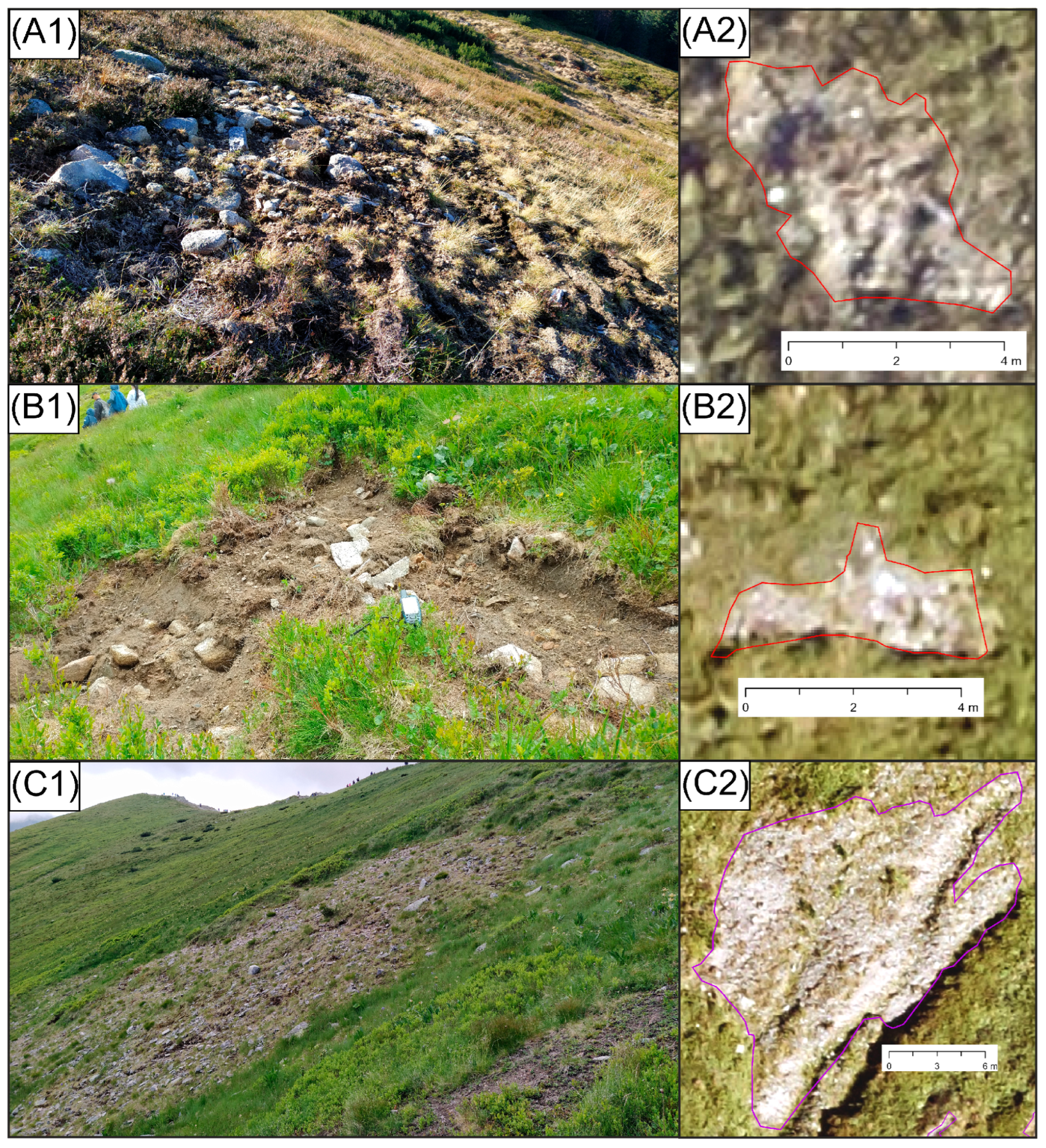
| Orthophoto | Source | Acquisition Date | Vertical Error (m) | Vertical Coordinate System |
|---|---|---|---|---|
| 2012 | Tatra National Park | 2012-08-19 | 0.2 | PL-KRON86-NH |
| 2019 | Tatra National Park | 2019-09-27, 2019-10-01 | 0.12 | PL-KRON86-NH |
| 2020 | Tatra National Park | 2020-08-21, 2020-08-22 | 0.2 | PL-KRON86-NH |
| 2023 | Head Office of Geodesy and Cartography in Poland | 2023-09-06 | 0.05 | PL-EVRF2007-NH |
| DEM | Source | Acquisition Date | Scanner | Point Density (Points per m2) | Horizontal Resolution (m) | Vertical Resolution from Receiver Specification (m) | Vertical Coordinate System |
|---|---|---|---|---|---|---|---|
| 2012 | ALS point cloud from the Head Office of Geodesy and Cartography in Poland | 2012-08-19 | Riegl LMS-Q680 | 9 | 1 | 0.07 to 0.15 | PL-KRON86-NH |
| 2019 | ALS point cloud from Tatra National Park | 2019-10-14, 2019-10-15 | Riegl VQ-780II | 27 | 1 | 0.04 | PL-KRON86-NH |
| 2020 | ALS point cloud from Tatra National Park | 2020-07-30, 2020-08-01 | Riegl VQ-780II | 27 | 1 | 0.04 | PL-KRON86-NH |
| 2023 | ALS point cloud from the Head Office of Geodesy and Cartography in Poland | 2023-09-06 | Riegl VQ-1560 II S | 12 | 1 | 0.1 | PL-EVRF2007-NH |
| DoD | ME (m) | SDE (m) | RMSE (m) | RMSE at 95% Confidence (m) |
|---|---|---|---|---|
| 2012–2023 | −0.058 | 0.146 | 0.157 | 0.309 |
| 2019–2020 | 0.009 | 0.046 | 0.047 | 0.092 |
| Year | Landform Type | Count | Total Area (m2) | Mean Area (m2) | Max. Area (m2) | Mean Circularity | SD Circularity | Mean Slope (°) | Max. Slope (°) |
|---|---|---|---|---|---|---|---|---|---|
| 2012 | Natural | 80 | 3981.31 | 49.77 | 399.40 | 0.49 | 0.20 | 27.10 | 36.44 |
| Snow Groomer-Eroded | 190 | 2122.71 | 11.17 | 147.51 | 0.62 | 0.17 | 22.90 | 42.88 | |
| 2019 | Natural | 81 | 3551.62 | 43.85 | 371.40 | 0.49 | 0.20 | 27.08 | 36.70 |
| Snow Groomer-Eroded | 195 | 1617.69 | 8.30 | 131.21 | 0.63 | 0.18 | 23.84 | 41.15 | |
| 2020 | Natural | 89 | 3780.89 | 42.64 | 390.65 | 0.46 | 0.20 | 26.03 | 36.59 |
| Snow Groomer-Eroded | 216 | 1833.53 | 8.49 | 139.26 | 0.61 | 0.18 | 23.68 | 41.15 | |
| 2023 | Natural | 78 | 3452.10 | 44.26 | 371.88 | 0.44 | 0.19 | 26.80 | 36.98 |
| Snow Groomer-Eroded | 248 | 1762.25 | 7.11 | 109.40 | 0.59 | 0.19 | 23.01 | 42.88 |
| Landform Type | Count | Total Area (m2) | Mean Area (m2) | Max. Area (m2) | Mean Circularity | Mean Slope (°) |
|---|---|---|---|---|---|---|
| Natural | 68 | 3189.53 | 46.91 | 355.96 | 0.45 | 27.89 |
| Snow Groomer-Eroded | 118 | 816.15 | 6.92 | 70.60 | 0.59 | 22.96 |
| Variable | Group of Landforms | Mean | Std. Dev. | t-Statistic | df | p-Value |
|---|---|---|---|---|---|---|
| Slope (°) | Natural | 27.89 | 5.19 | −4.949 | 183 | <0.000001 |
| Snow Groomer-Eroded | 22.96 | 7.14 | ||||
| Circularity | Natural | 0.46 | 0.20 | 5.641 | 184 | <0.000001 |
| Snow Groomer-Eroded | 0.61 | 0.18 |
| Variable | Group of Landforms | Mean | Std. Dev. | t-Statistic | df | p-Value |
|---|---|---|---|---|---|---|
| Slope (°) | Non-Persistent | 23.17 | 7.29 | 0.266 | 500 | <0.790249 |
| Persistent | 22.96 | 7.14 | ||||
| Circularity | Non-Persistent | 0.62 | 0.19 | 1.413 | 500 | <0.158351 |
| Persistent | 0.59 | 0.15 |
| Period | Landform Type | Count | Total Area (m2) | Volume (m3) | Normalised Volume (m3/m2) | ||||||||||
|---|---|---|---|---|---|---|---|---|---|---|---|---|---|---|---|
| Landforms | Eroding Landforms | Deposition Landforms | Unchanged Landforms | Landforms at the End of Period | Changed Landforms | Eroding Landforms | Deposition Landforms | Total Net Change | Total Erosion | Total Deposition | Total | Erosion | Deposition | ||
| 2012–2023 | Natural | 78 | 1 | 20 | 57 | 3452.10 | 2140.84 | 52.2433 | 2088.60 | +8.196 ± 0.309 | −0.828 ± 0.309 | +9.024 ± 0.309 | +0.004 | −0.016 | +0.004 |
| Snow Groomer-Eroded | 248 | 11 | 19 | 218 | 1762.25 | 415.83 | 72.22 | 341.59 | −2.070 ± 0.309 | −6.363 ± 0.309 | +4.292 ± 0.309 | −0.005 | −0.088 | +0.013 | |
| 2019–2020 | Natural | 89 | 67 | 2 | 20 | 3780.89 | 3654.57 | 3647.57 | 6.99 | −163.651 ± 0.092 | −163.676 ± 0.092 | +0.025 ± 0.092 | −0.045 | −0.045 | +0.004 |
| Snow Groomer-Eroded | 216 | 112 | 4 | 100 | 1833.53 | 1347.85 | 1300.98 | 46.87 | −33.765 ± 0.092 | −33.884 ± 0.092 | +0.119 ± 0.092 | −0.025 | −0.026 | +0.003 | |
Disclaimer/Publisher’s Note: The statements, opinions and data contained in all publications are solely those of the individual author(s) and contributor(s) and not of MDPI and/or the editor(s). MDPI and/or the editor(s) disclaim responsibility for any injury to people or property resulting from any ideas, methods, instructions or products referred to in the content. |
© 2025 by the authors. Licensee MDPI, Basel, Switzerland. This article is an open access article distributed under the terms and conditions of the Creative Commons Attribution (CC BY) license (https://creativecommons.org/licenses/by/4.0/).
Share and Cite
Piątek, D.; Krzemień, K. The Impact of Snow Grooming on Morphology and Erosion of Alpine Hillslopes: A Case Study from Kasprowy Wierch Ski Station in the Tatra Mountains. Land 2025, 14, 1870. https://doi.org/10.3390/land14091870
Piątek D, Krzemień K. The Impact of Snow Grooming on Morphology and Erosion of Alpine Hillslopes: A Case Study from Kasprowy Wierch Ski Station in the Tatra Mountains. Land. 2025; 14(9):1870. https://doi.org/10.3390/land14091870
Chicago/Turabian StylePiątek, Dawid, and Kazimierz Krzemień. 2025. "The Impact of Snow Grooming on Morphology and Erosion of Alpine Hillslopes: A Case Study from Kasprowy Wierch Ski Station in the Tatra Mountains" Land 14, no. 9: 1870. https://doi.org/10.3390/land14091870
APA StylePiątek, D., & Krzemień, K. (2025). The Impact of Snow Grooming on Morphology and Erosion of Alpine Hillslopes: A Case Study from Kasprowy Wierch Ski Station in the Tatra Mountains. Land, 14(9), 1870. https://doi.org/10.3390/land14091870








